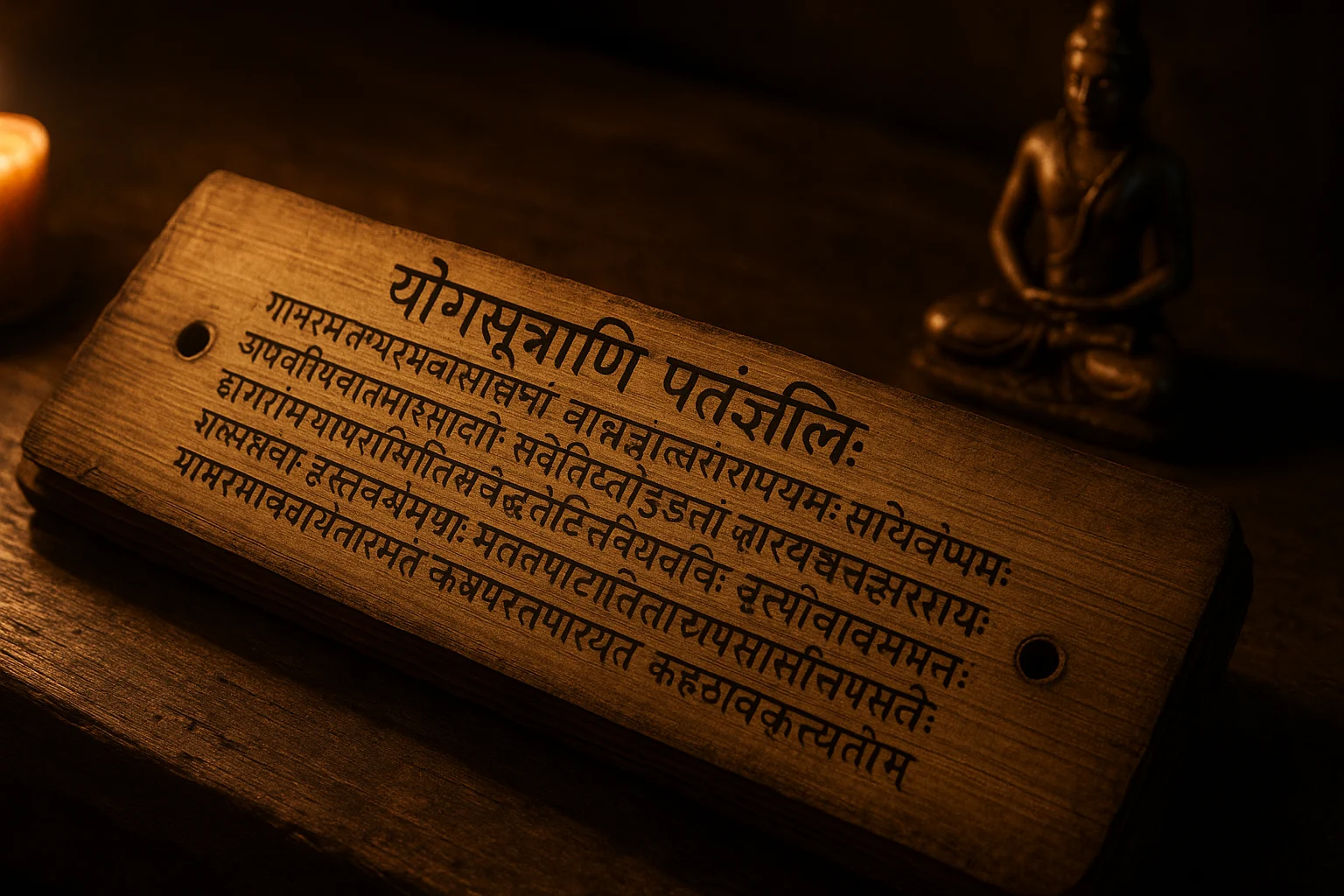
How many yoga sutras are there? 196. In just 196 lines, Patanjali sketches a complete map for the mind. This yoga sutras guide shows how they’re structured, what they mean, and how to use them today. For context, see our yoga philosophy guide.
Find Your Sutra Now!This page contains paid/affiliate links. As an Amazon Associate we earn from qualifying purchases, and we may earn commissions from other partners—at no extra cost to you. Links marked with ‘#ad’ are affiliate links, meaning we may earn a commission at no extra cost to you. Learn more.
Table of Contents
- Key Takeaways
- How Many Yoga Sutras Are There? The Definitive Count
- Who Wrote the Yoga Sutras and When?
- The Four Chapters: Sutras per Chapter
- The Enduring Wisdom of Patanjali’s Sutras
- Bringing the Sutras into Your Practice
- Find Your Yoga Sutra
- Frequently Asked Questions
- Conclusion: A Timeless Blueprint for Yoga
Key Takeaways
- Total Sutras: There are officially 196 Yoga Sutras compiled by the sage Patanjali, serving as a comprehensive guide to yoga philosophy and practice.
- Four Chapters (Padas): The Sutras are organized into four distinct chapters: Samadhi Pada (Contemplation), Sadhana Pada (Practice), Vibhuti Pada (Accomplishments), and Kaivalya Pada (Liberation).
- Ancient Origins: Attributed to Patanjali, these sutras were compiled between 200 BCE and 400 CE, synthesizing existing yogic knowledge.
- Practical Guidance: Beyond philosophy, the Yoga Sutras offer practical techniques like Ashtanga Yoga (the eight limbs) and Kriya Yoga, directly influencing modern yoga practice.
- Timeless Relevance: Despite their age, the Sutras remain a vital resource for understanding the mind, cultivating inner peace, and achieving higher states of consciousness.
How Many Yoga Sutras Are There? The 196-Verse Count
Yoga Sutra Overview: The 196 Sutras Explained
Answer: 196. Patanjali’s text comprises 196 concise aphorisms (“sutras”)—short lines that pack deep insight for chanting, study, or meditation. For a concise reference, see Britannica’s overview of the Yoga-sutras.
Each sutra is a seed, blooming with meaning through practice. Patanjali crafted them to be memorized, sparking a personal connection to yoga’s heart.
Who Wrote the Yoga Sutras and When?
The Yoga Sutras—often called the Patanjali Sutras—are credited to the sage Patanjali, though his exact identity is debated. Scholars place the compilation between 200 BCE and 400 CE, organizing earlier yogic knowledge into a clear system. For a widely used translation, see The Yoga Sutras of Patanjali (Swami Satchidananda).
The text also draws on Samkhya: the “seer” (Purusha) is distinct from “nature” (Prakriti). That lens makes clear yoga is more than posture work.
- Abhyāsa: Steady practice to focus the mind.
- Vairāgya: Non-attachment, letting go of desires.
- Samādhi: Deep meditative absorption or union.
- Purusha: Pure consciousness or the true self.
- Prakriti: Material nature, the external world.

The Four Chapters (Padas): What Each One Covers
Patanjali arranges the teachings into four padas (“quarters”). Each builds on the last—from how the mind works to how freedom is realized. Here’s the gist:
1. Samadhi Pada: Contemplation (51 Sutras)
Number of Sutras: 51
Key Theme: This chapter dives into the mind’s nature and yoga’s core aim. Its opening sutra, Yogaś citta-vṛtti-nirodhaḥ (Yoga stills the mind’s fluctuations), sets the tone for everything.
What it Teaches:
- Defining Yoga: It shows how yoga quiets mental noise.
- Mind’s Nature: Patanjali lists five mental states, like correct knowledge or fantasy.
- Practice & Detachment: Steady practice (abhyasa) and letting go (vairagya) calm the mind.
- Types of Samadhi: It covers meditative absorption levels, from basic to profound.
Relevance Today: Samadhi Pada’s tools for clarity are gold in our hectic world. Practicing vairagya helped me release stress, finding calm in quiet moments.
2. Sadhana Pada: Practice (55 Sutras)
Number of Sutras: 55
Key Theme: This hands-on chapter shares practices like Kriya Yoga and yoga’s eight limbs to achieve mental stillness.
What it Teaches:
- Kriya Yoga: Includes tapas (discipline), svadhyaya (self-study), and Ishvara pranidhana (surrender).
- Ashtanga Yoga (Eight Limbs): A full path with:
- Yamas: Ethical principles like ahimsa (non-violence).
- Niyamas: Disciplines like saucha (purity).
- Asana: Physical postures.
- Pranayama: Breath control.
- Pratyahara: Sense withdrawal.
- Dharana: Concentration.
- Dhyana: Meditation.
- Samadhi: Superconsciousness.
Relevance Today: Sadhana Pada roots modern yoga in ethical principles. Practicing ahimsa reshaped how I handle conflicts, choosing kindness over impulse.

3. Vibhuti Pada: Accomplishments (56 Sutras)
Number of Sutras: 56
Key Theme: This chapter explores meditation’s outcomes, like siddhis (spiritual powers), but warns against getting hooked on them.
What it Teaches:
- Samyama: Merging concentration, meditation, and absorption on one focus.
- Siddhis: Powers like past-life recall or levitation, often metaphors for deeper intuition.
- Warning: Chasing these powers can derail liberation.
Relevance Today: The idea of siddhis feels wild, but meditation has sharpened my gut instincts, helping me make clearer choices.
4. Kaivalya Pada: Liberation (34 Sutras)
Number of Sutras: 34
Key Theme: This short chapter unveils Kaivalya, total freedom where the Self escapes mind and matter.
What it Teaches:
- Liberation: The Self rests in its true essence, free from mental chatter.
- Karma: Yoga clears subconscious patterns and karmic cycles.
- Gunas: Liberation transcends nature’s qualities (sattva, rajas, tamas).
- Dharma Megha Samadhi: The ultimate samadhi dissolves karma.
Relevance Today: Kaivalya Pada feels like a guide through life’s noise, pointing me toward lasting peace.
- Yogaś citta-vṛtti-nirodhaḥ (I.2) — “Yoga is the stilling of the mind’s fluctuations.”
- Abhyāsa–vairāgya (I.12–16) — practice and letting go as twin tools.
- Kriyā-yoga (II.1) — tapas, svādhyāya, Īśvara-praṇidhāna.
- Aṣṭāṅga-yoga (II.29) — the eight limbs, from yamas to samādhi.
The Enduring Wisdom of Patanjali’s Sutras
The Yoga Sutras are more than old texts; they’re a living guide shaping yoga today. Their focus on taming the mind hits home in our busy lives. B.K.S. Iyengar calls them a timeless map for self-realization in his Light on the Yoga Sutras, as explored in our yoga philosophy guide. Their benefits include:
- Mind Management: Tools to quiet mental noise, key for mental health.
- Ethical Living: Yamas and Niyamas shape how we connect with others.
- Holistic Well-being: Blending postures, breath, and meditation for health.
- Self-Realization: A path to rise above ego and find true peace.
Styles like Ashtanga Vinyasa lean heavily on these ideas, especially asana and pranayama.
Yoga Sutras Guide: Bringing the Sutras into Your Practice
The Yoga Sutras can feel intense, but pairing them with mindfulness practices makes them approachable. Here’s a simple way to start:
- Start Small: Pick a few sutras from Sadhana Pada and reflect on them.
- Find a Commentary: Swami Satchidananda or B.K.S. Iyengar’s books unpack the depth.
- Join a Study Group: Sharing insights with others opens new angles.
- Apply the Principles: Live the Yamas, like satya (truthfulness), every day.
- Be Patient: Their wisdom grows with steady effort over time.
Embracing santosha (contentment) helps many practitioners find joy in small moments—like a quiet morning flow.
- Read one Sadhana Pada sutra daily (try II.29 on the eight limbs).
- Practice ahimsa: avoid one harsh thought or word.
- Join a yoga study group to discuss insights.
Find Your Yoga Sutra
Click a button to find a Yoga Sutra that speaks to your current life moment.
Frequently Asked Questions
Conclusion: A Timeless Blueprint for Yoga
Asking this question opens a door to 196 verses of profound wisdom. Patanjali’s Yoga Sutras are a roadmap for mastering the mind and finding freedom. Whether you’re a yogi or just curious, these teachings spark peace and clarity. Dive in and let them guide you!


